Mikael Agricola
This article needs additional citations for verification. (November 2018) |
The Right Reverend Mikael Agricola | |
|---|---|
Finnish | |
| Denomination | Lutheran |
| Part of a series on |
| Lutheranism |
|---|
 |
Mikael Agricola (Finnish:
Agricola was consecrated as the
He died of sudden illness while returning from a trip during which he assisted in negotiating the Treaty of Novgorod with the Tsardom of Moscovy.
Biography
Early life
Michael Olaui or Mikael Olofsson (Finnish Mikael Olavinpoika) was born in c. 1510 in the village of Torsby in Pernå (Pernaja), Nyland (Uusimaa), in what now is part of Finland but then was part of Sweden. He was named after the patron saint of Pernå's church. The exact date of his birth, like most details of his life, is unknown. His family was a quite wealthy gentry family according to the local bailiff's accounting. He had three sisters, but their names are not known. His teachers apparently recognized his aptitude for languages and his rector Bartholomeus sent him to Viborg (Fi. Viipuri; now Vyborg, Russia) for Latin school and some priestly training, where he attended the school of Erasmus. It is not known whether his first language was Finnish or Swedish; Pernå was mostly a Swedish-speaking district, but the language he used in his works indicates that he was a native speaker of Finnish.[1] However, he mastered both languages like a native speaker and was possibly a bilingual child.[2]
Studies
When Michael studied in
In 1528 Agricola followed his teacher to Turku (Åbo), then the center of the Finnish side of the Swedish realm and the capital of the bishopric. There Agricola became a scribe in bishop Martinus Skytte's office.[2] While in Turku Agricola met Martin Luther's first Finnish student Petrus Särkilahti, who eagerly spread the idea of the Reformation. Särkilahti died in 1529, and it was up to Agricola to continue Särkilahti's work. Agricola was ordained for priesthood sometime in the early 1530s.[3]
In 1536 the bishop of Turku sent Agricola to study in
Rector and ordinarius
In 1539 Agricola returned to Turku and ended up as the rector of Turku (Cathedral) School. He did not like his job, calling his students "untamed animals". At the time Gustav Vasa had confiscated the property of the church when he was consolidating his power but he also drove the Reformation. In 1544 Agricola received an order from the crown to send several talented young men to Stockholm's taxing offices. For some reason, Agricola did not obey until the order was sent again the next year, with a more menacing tone. This episode probably affected their relations negatively.[3]
In 1546 Agricola lost his home and school in the Fire of Turku. On 22 February 1548, Gustav Vasa ordered Agricola to retire from his position as a rector. At this time Agricola was already married, but history knows his wife only by her name: Pirjo Olavintytär (Bridget, "daughter of Olavi"; Birgitta Olafsdotter, Brigida Olaui). His only son, Christian Agricola (Christianus Michaelis Agricola), was born 11 December 1550, and became the bishop of Tallinn in 1584.[citation needed]
When an old bishop died in 1554, Gustav Vasa had Agricola consecrated as the
Death
In 1557, Agricola headed a delegation going to
Literary achievements
Abckiria
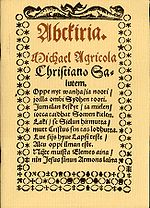
Agricola had thought about translating the New Testament in his early years of study. At the time, however, there was no standard written form of Finnish, so he started developing it. His first book, Abckiria, which is nowadays known as the "ABC-kirja" or ABC book, was a primer for reading and a catechism. It was first printed in 1543.[7] The catechism was included because only very few people could afford the whole Bible at the time. The first printing contained 16 pages.
A second printing was released in 1551[3] with 24 pages.
In 1966 Åke Åbergin, a librarian, discovered parts, while repairing book bindings, from an as yet unknown (likely the third) edition of the "ABC-kirja" that included the name of the printer, Amund Lauritsanpoika, and fortuitously the publishing date of 1559 (two years after the author's death) of the final as yet undiscovered 8 pages. The pages were likely the result of an imposing error and relegated to padding paper.[8]
Rucouskiria
Agricola's Rucouskiria Bibliasta (contemporary Finnish spelling: Rukouskirja; literally, "Prayer Book from the Bible") was printed in March 1544. At the beginning of the book, Agricola wrote about many topics concerning all-round
New Testament translation
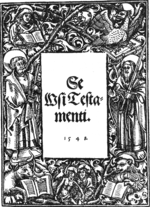
Agricola's most prominent book is the first Finnish-language translation of the New Testament. The manuscript was completed in 1548. It contains 718 pages and many illustrations.[7]
Liturgical books
While Agricola was in Wittenberg, he translated three smaller liturgical books into Finnish. These books were printed in 1549.[7]
Käsikirja Castesta ia muista Christikunnan Menoista includes forms for christening, marriage and burial, as well as speeches for the sick, mourning and dying. It is translated from Olaus Petri's corresponding work except for the christening and marriage portions, which are from Luther. It also contains minor elements translated from works of Caspar Huberinus.
Messu eli Herran echtolinen includes the form for a service. It is also based on Olaus Petri's work and a few Finnish manuscripts. In this book Agricola revealed his next mission: the translation of the Old Testament.[3]
Se meiden Herran Jesusen Christusen Pina, ylesnousemus ia tauiaisen Astumus, niste Neliest Euangelisterist coghottuon tells about Jesus Christ's suffering. It is collected from all four gospels. This book was influenced heavily by Johannes Bugenhagen,[7] a teacher in Wittenberg. It was mainly translated from the German version, but some parts are influenced by the Swedish version and Agricola's own translation of the New Testament.[citation needed]
Commemorations

The Evangelical Lutheran Church in America remembers Bishop Agricola annually on 10 April.[citation needed]
Mikael Agricola Church in Helsinki is named after Agricola.[9] As well the Agricola Lutheran Church memorializes his namesake in Toronto Canada. An asteroid 3212 Agricola is named after Agricola.
In 2007, 450 years after his death, Agricola was selected as the main motif for a commemorative coin, the €10 Mikael Agricola and Finnish language commemorative coin. This collector coin was issued to honor Agricola's life work as a contributor to the Protestant reformation in Finland and as the father of the Finnish written language. The reverse side depicts a quill to reference the writer, while the coin's obverse side contains an artistic interpretation of a human figure.[10]
Gallery
-
The original statue of Mikael Agricola in Vyborg by Emil Wikström, photographed on the day of its reveal in 21 June 1908
[note 1] -
1910 recast in the Turku Cathedral
-
1953 recast in Lahti
-
Monument near the place of Agricola's death, close to Primorsk
-
Plaque to Agricola in Wittenberg
-
Mikael Agricola Church in Helsinki named after him
-
Statue of Agricola by Carl Eneas Sjöstrand, 1877
-
Statue of Agricola by Ville Vallgren in the Helsinki Cathedral, 1887
-
Mikael Agricola Hands Over the Finnish Translation of theGustav Wasa, Robert Wilhelm Ekman, 1853
-
Educational poster of Agricola handing Se Wsi Testamenti, the Finnish translation of the New Testament, to Gustav Vasa by Albert Gebhard
-
The Death of Agricola by Joseph Alanen, 1917
See also
Notes
- ^ The statue was lost in the Winter War.[11]
- ^ The statue was 1993–2009 inside Vyborg Library
References
- ISBN 978-951-583-212-2.
- ^ a b c Heininen, Simo (2014). "Agricola, Mikael (1510–1557)". The National Biography of Finland. Retrieved 30 April 2016.
- ^ ISSN 1799-4349. Retrieved 23 August 2021.
- ^ Lutheran Cyclopedia entry on Agricola, Michael.
- ISBN 3-525-55444-3.
- ^ Kauppila, Suvi (28 February 2012). "Arkeologit etsivät Mikael Agricolan hautaa Viipurissa" (in Finnish). University of Turku. Archived from the original on 8 December 2015.
- ^ a b c d e "Kirjallinen työ". Finnish Bible Society (in Finnish). 2007. Archived from the original on 12 May 2016. Retrieved 30 April 2016.
- ISBN 951-717-303-2.
- ^ "Mikael Agricola Church". Archived from the original on 11 March 2016. Retrieved 30 April 2016.
- ^ :: Mikael Agricolan juhlaraha Kolikot.com
- ^ "Muistomerkkihanke 2009" (in Finnish). Mikael Agricola – seura. Retrieved 23 August 2021.
External links
 Media related to Mikael Agricola at Wikimedia Commons
Media related to Mikael Agricola at Wikimedia Commons- Spreading the Written Word: Mikael Agricola and the Birth of Literary Finnish by Kaisa Häkkinen
- Agricola, Suomen kirjakielen isä (in Finnish) Finnish Bible Society
- Mikael Agricola Society (in Finnish)

![The original statue of Mikael Agricola in Vyborg by Emil Wikström, photographed on the day of its reveal in 21 June 1908 [note 1]](http://upload.wikimedia.org/wikipedia/commons/thumb/4/4f/M._L._Carstens_-_Photograph_of_the_original_statue_of_Mikael_Agricola_in_Vyborg_by_Emil_Wikstr%C3%B6m_.jpg/275px-M._L._Carstens_-_Photograph_of_the_original_statue_of_Mikael_Agricola_in_Vyborg_by_Emil_Wikstr%C3%B6m_.jpg)

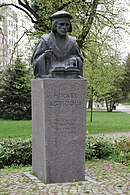
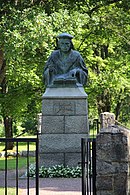
![New 1993 recast in Vyborg [note 2]](http://upload.wikimedia.org/wikipedia/commons/thumb/6/6a/Vyborg_June2012_Teatralnaya_Square_Agricola_Monument.jpg/137px-Vyborg_June2012_Teatralnaya_Square_Agricola_Monument.jpg)
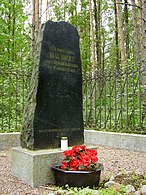
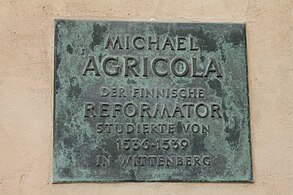




![Educational poster of Agricola handing Se Wsi Testamenti, the Finnish translation of the New Testament, to Gustav Vasa by Albert Gebhard [fi]](http://upload.wikimedia.org/wikipedia/commons/thumb/e/e2/Albert_Gebhard_-_Gustav_Vasa_and_Mikael_Agricola.jpg/267px-Albert_Gebhard_-_Gustav_Vasa_and_Mikael_Agricola.jpg)
![The Death of Agricola by Joseph Alanen [fi], 1917](http://upload.wikimedia.org/wikipedia/commons/thumb/2/2a/Joseph_Alanen_-_The_Death_of_Agricola.jpg/238px-Joseph_Alanen_-_The_Death_of_Agricola.jpg)
